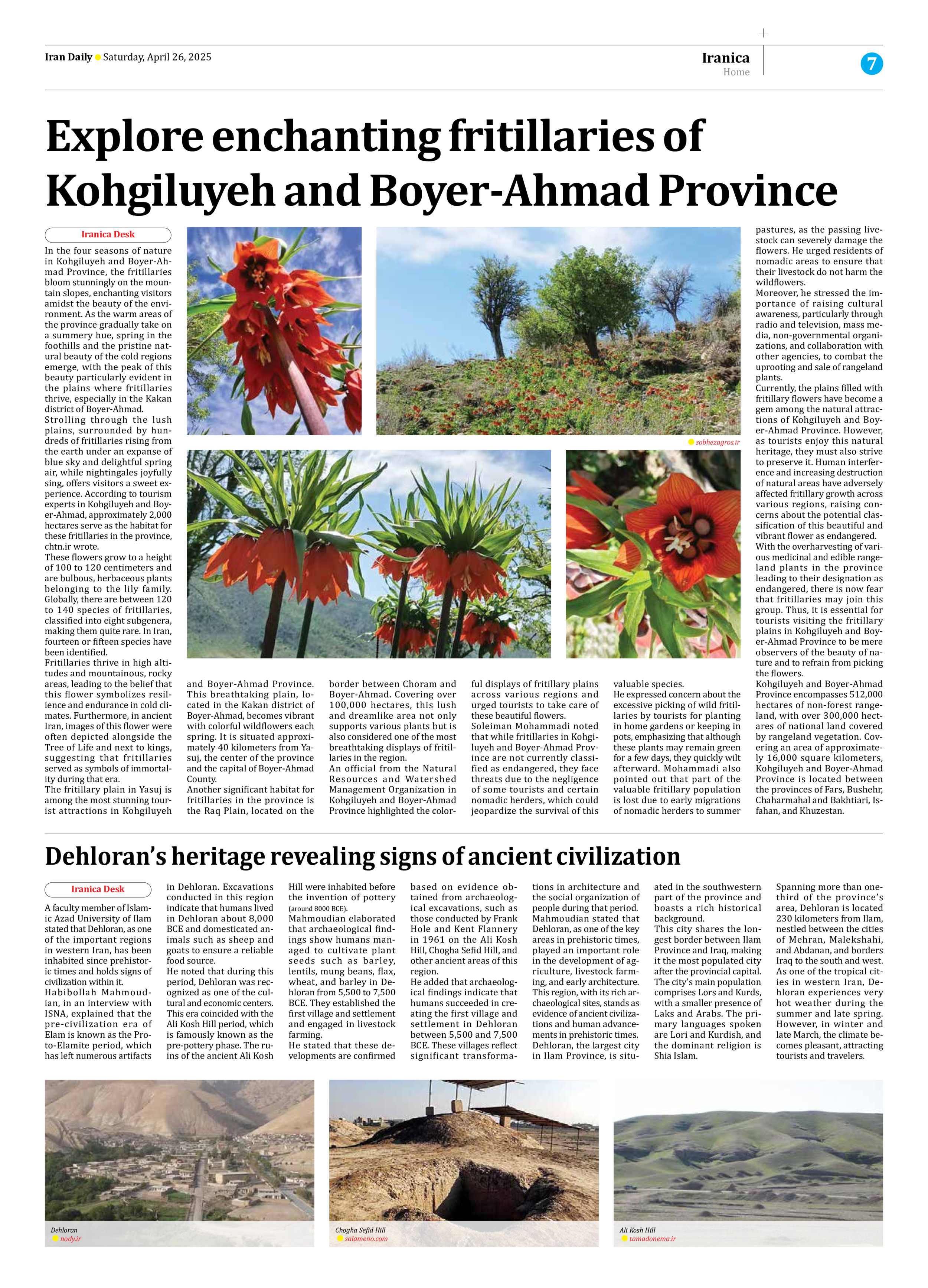
Explore enchanting fritillaries of Kohgiluyeh and Boyer-Ahmad Province
In the four seasons of nature in Kohgiluyeh and Boyer-Ahmad Province, the fritillaries bloom stunningly on the mountain slopes, enchanting visitors amidst the beauty of the environment. As the warm areas of the province gradually take on a summery hue, spring in the foothills and the pristine natural beauty of the cold regions emerge, with the peak of this beauty particularly evident in the plains where fritillaries thrive, especially in the Kakan district of Boyer-Ahmad.
Strolling through the lush plains, surrounded by hundreds of fritillaries rising from the earth under an expanse of blue sky and delightful spring air, while nightingales joyfully sing, offers visitors a sweet experience. According to tourism experts in Kohgiluyeh and Boyer-Ahmad, approximately 2,000 hectares serve as the habitat for these fritillaries in the province, chtn.ir wrote.
These flowers grow to a height of 100 to 120 centimeters and are bulbous, herbaceous plants belonging to the lily family. Globally, there are between 120 to 140 species of fritillaries, classified into eight subgenera, making them quite rare. In Iran, fourteen or fifteen species have been identified.
Fritillaries thrive in high altitudes and mountainous, rocky areas, leading to the belief that this flower symbolizes resilience and endurance in cold climates. Furthermore, in ancient Iran, images of this flower were often depicted alongside the Tree of Life and next to kings, suggesting that fritillaries served as symbols of immortality during that era.
The fritillary plain in Yasuj is among the most stunning tourist attractions in Kohgiluyeh and Boyer-Ahmad Province. This breathtaking plain, located in the Kakan district of Boyer-Ahmad, becomes vibrant with colorful wildflowers each spring. It is situated approximately 40 kilometers from Yasuj, the center of the province and the capital of Boyer-Ahmad County.
Another significant habitat for fritillaries in the province is the Raq Plain, located on the border between Choram and Boyer-Ahmad. Covering over 100,000 hectares, this lush and dreamlike area not only supports various plants but is also considered one of the most breathtaking displays of fritillaries in the region.
An official from the Natural Resources and Watershed Management Organization in Kohgiluyeh and Boyer-Ahmad Province highlighted the colorful displays of fritillary plains across various regions and urged tourists to take care of these beautiful flowers.
Soleiman Mohammadi noted that while fritillaries in Kohgiluyeh and Boyer-Ahmad Province are not currently classified as endangered, they face threats due to the negligence of some tourists and certain nomadic herders, which could jeopardize the survival of this valuable species.
He expressed concern about the excessive picking of wild fritillaries by tourists for planting in home gardens or keeping in pots, emphasizing that although these plants may remain green for a few days, they quickly wilt afterward. Mohammadi also pointed out that part of the valuable fritillary population is lost due to early migrations of nomadic herders to summer pastures, as the passing livestock can severely damage the flowers. He urged residents of nomadic areas to ensure that their livestock do not harm the wildflowers.
Moreover, he stressed the importance of raising cultural awareness, particularly through radio and television, mass media, non-governmental organizations, and collaboration with other agencies, to combat the uprooting and sale of rangeland plants.
Currently, the plains filled with fritillary flowers have become a gem among the natural attractions of Kohgiluyeh and Boyer-Ahmad Province. However, as tourists enjoy this natural heritage, they must also strive to preserve it. Human interference and increasing destruction of natural areas have adversely affected fritillary growth across various regions, raising concerns about the potential classification of this beautiful and vibrant flower as endangered.
With the overharvesting of various medicinal and edible rangeland plants in the province leading to their designation as endangered, there is now fear that fritillaries may join this group. Thus, it is essential for tourists visiting the fritillary plains in Kohgiluyeh and Boyer-Ahmad Province to be mere observers of the beauty of nature and to refrain from picking the flowers.
Kohgiluyeh and Boyer-Ahmad Province encompasses 512,000 hectares of non-forest rangeland, with over 300,000 hectares of national land covered by rangeland vegetation. Covering an area of approximately 16,000 square kilometers, Kohgiluyeh and Boyer-Ahmad Province is located between the provinces of Fars, Bushehr, Chaharmahal and Bakhtiari, Isfahan, and Khuzestan.







